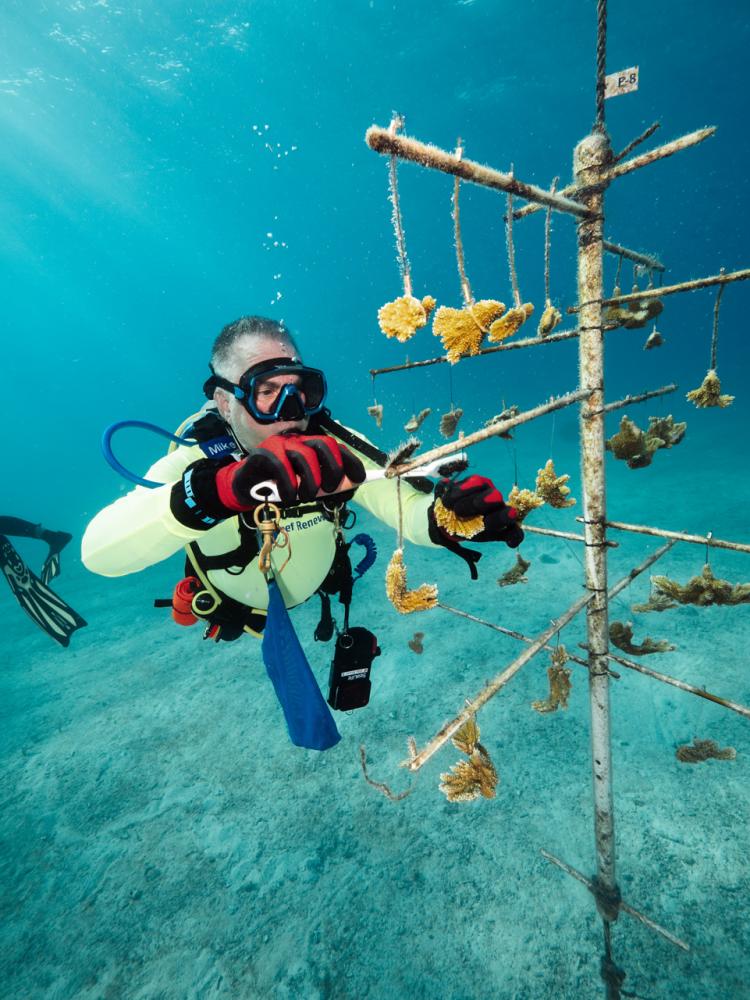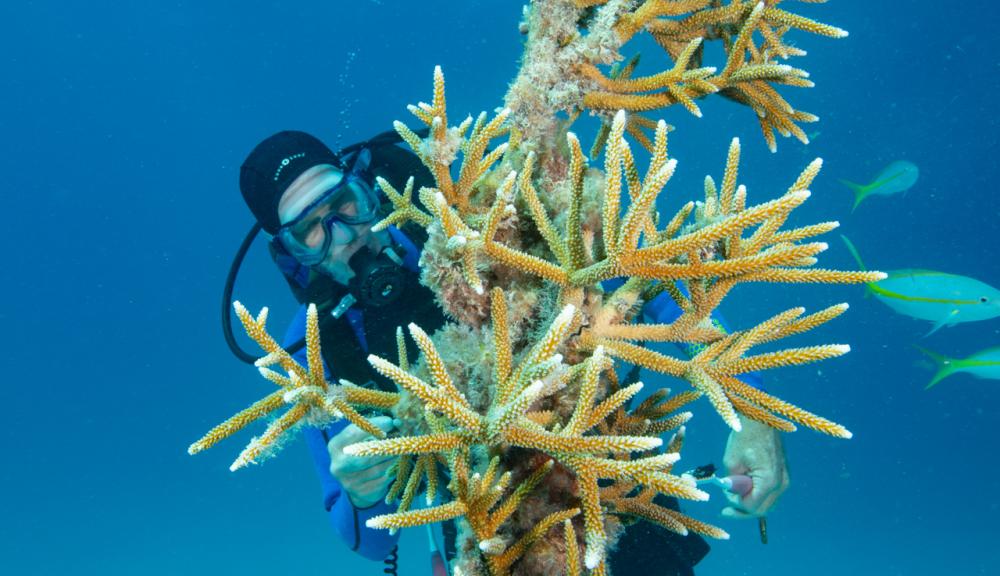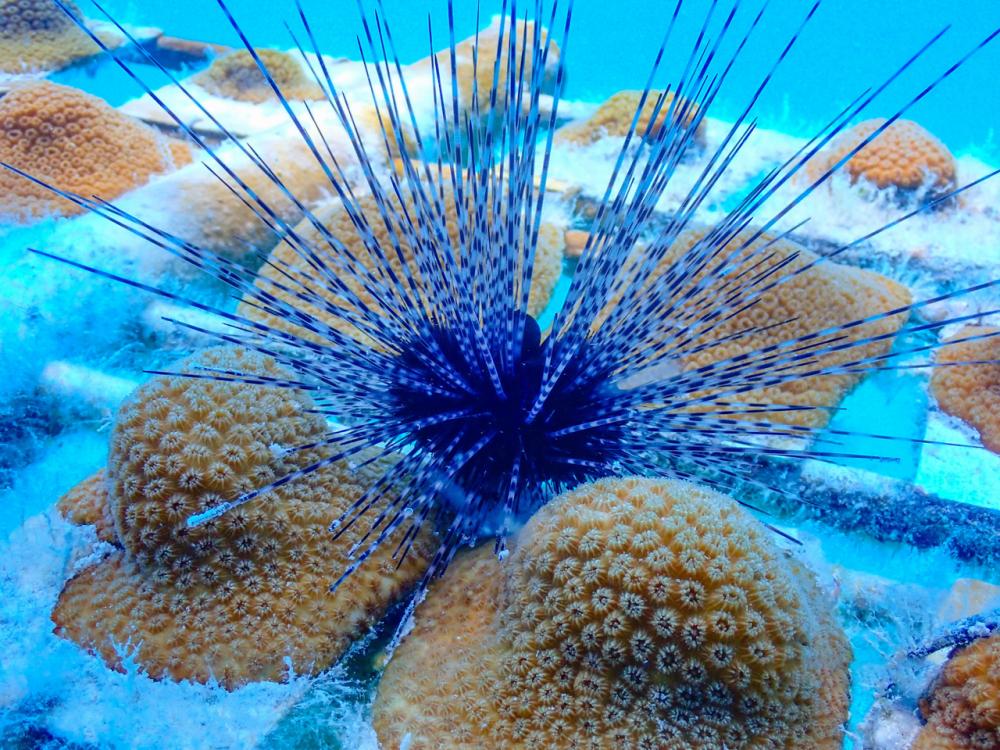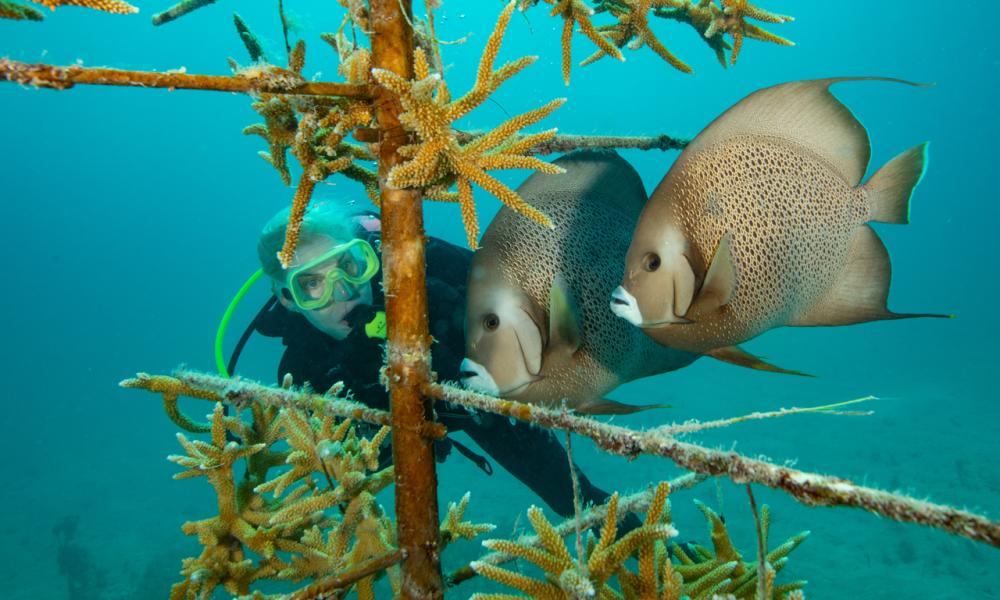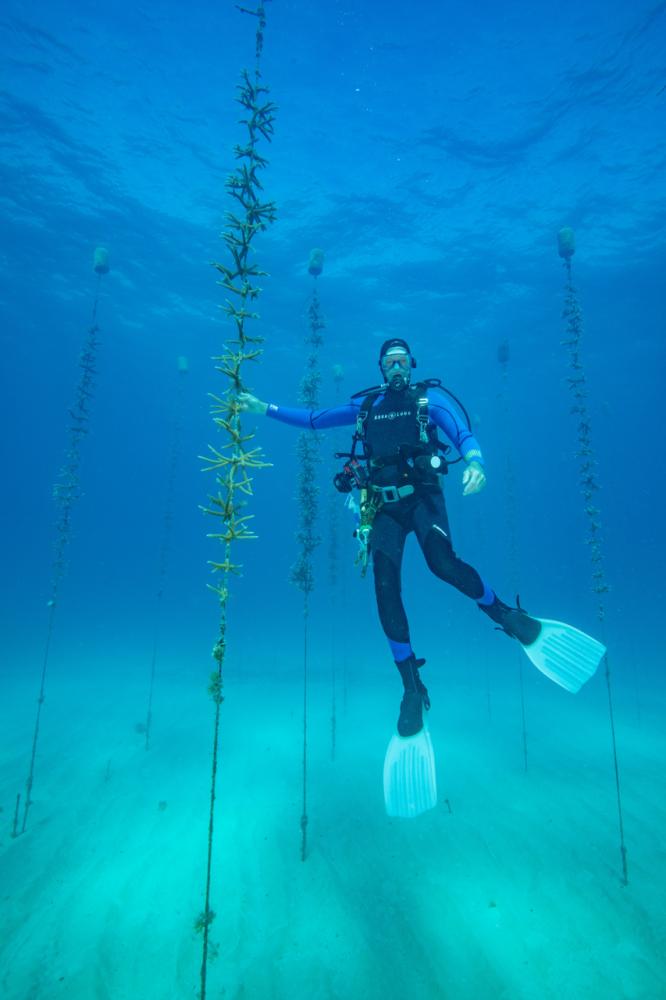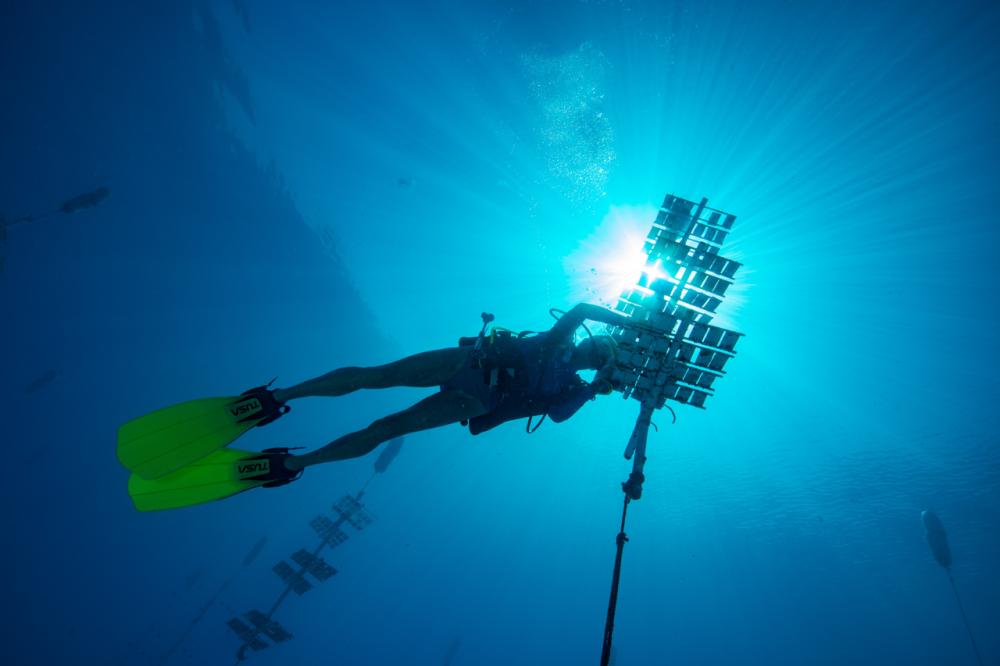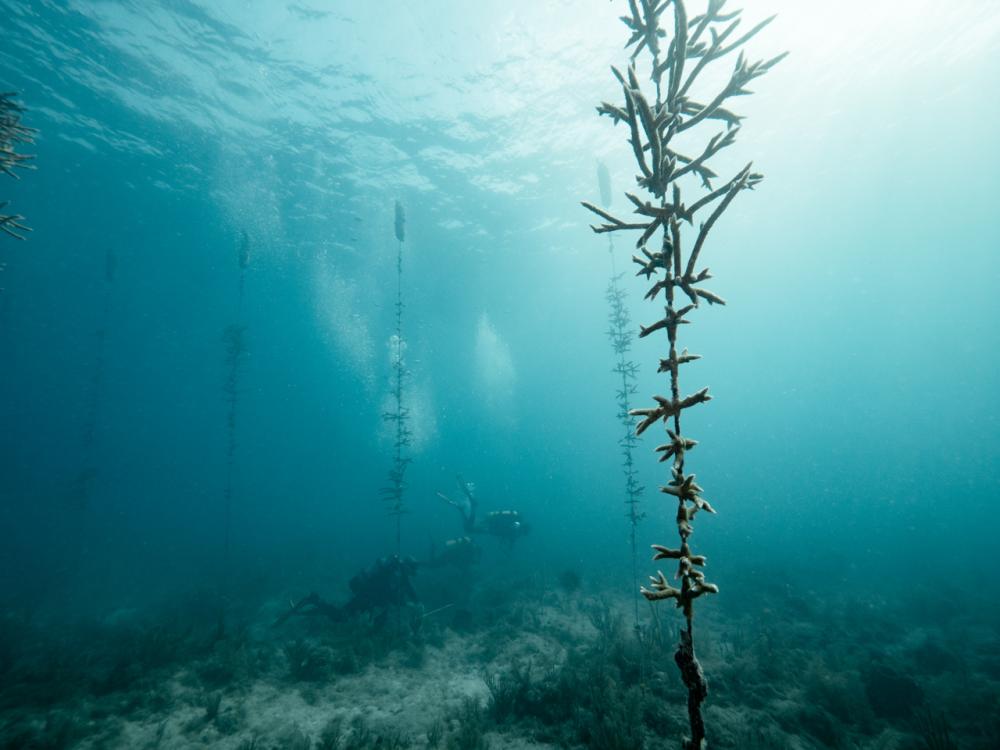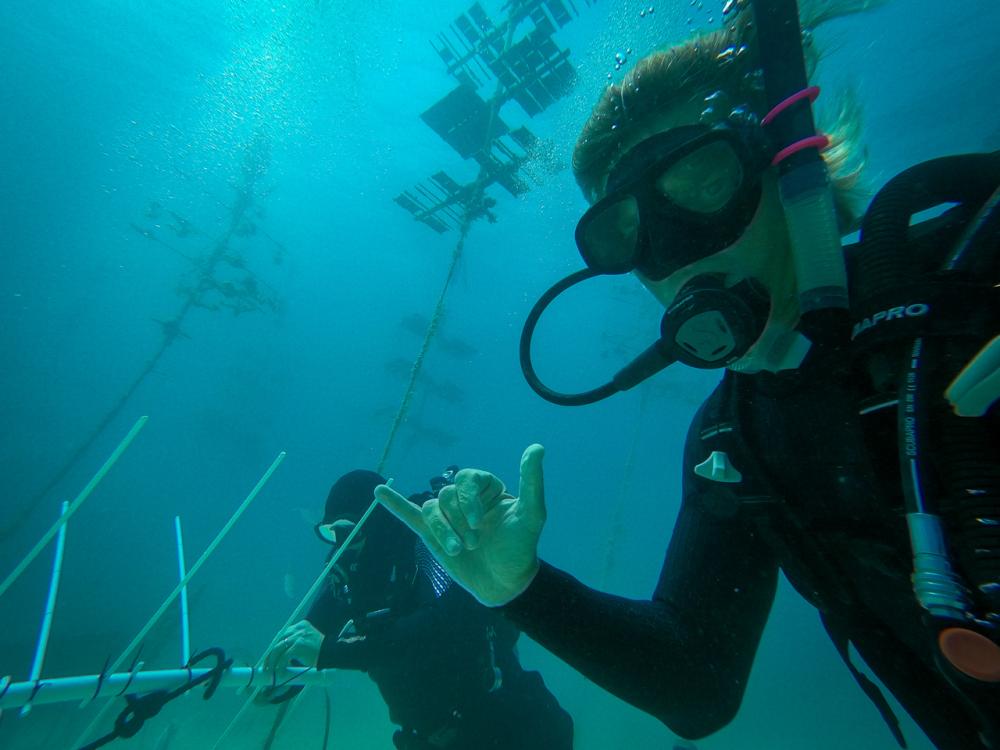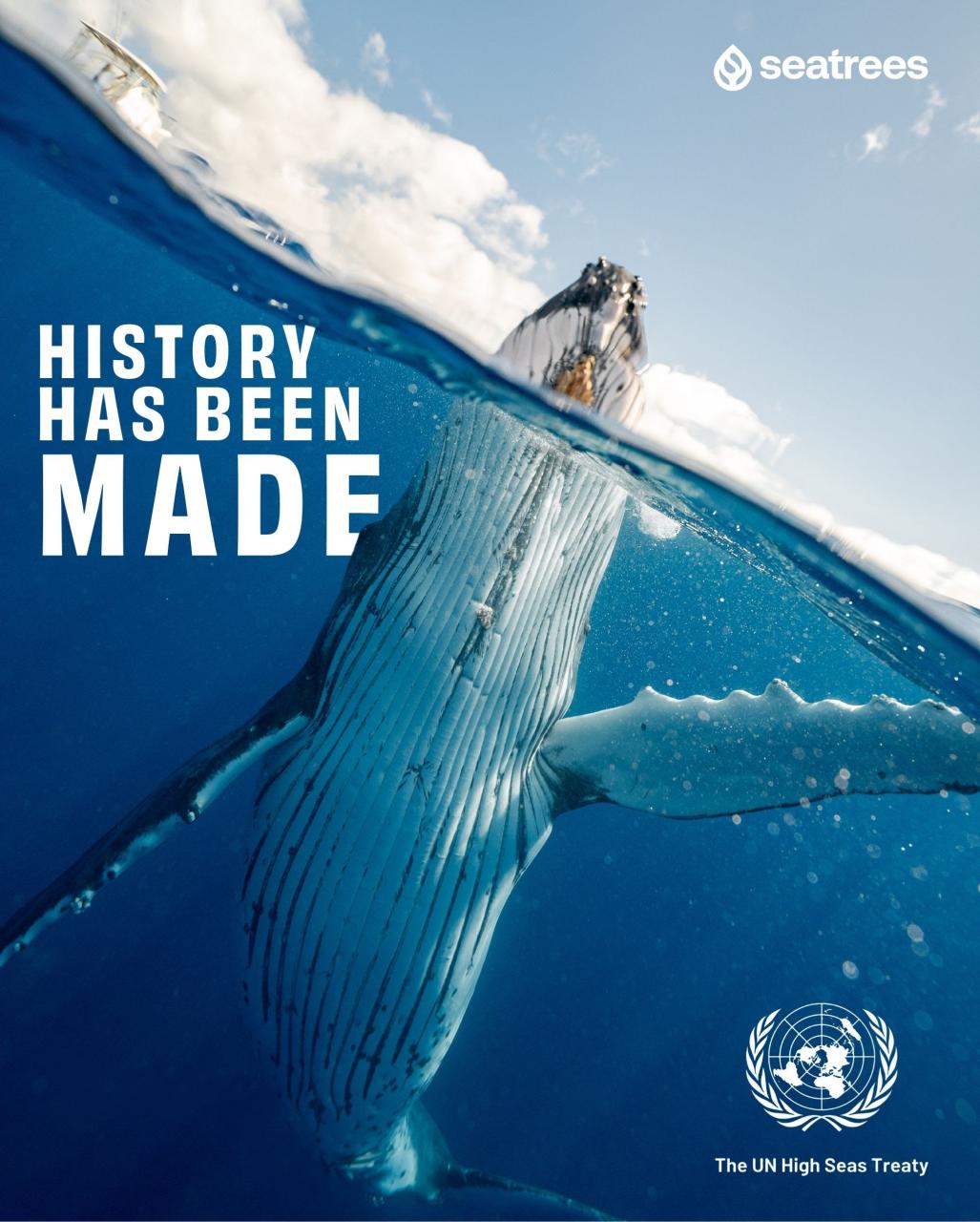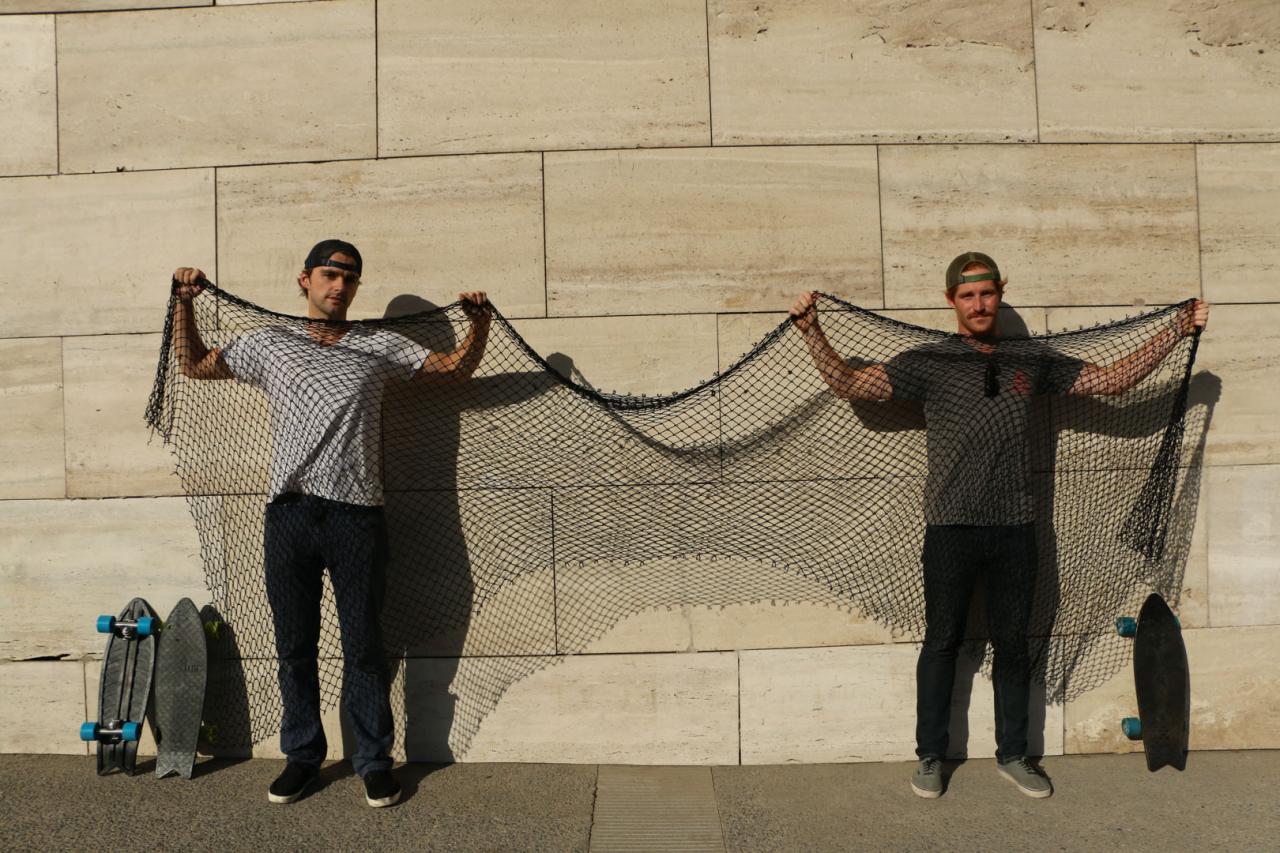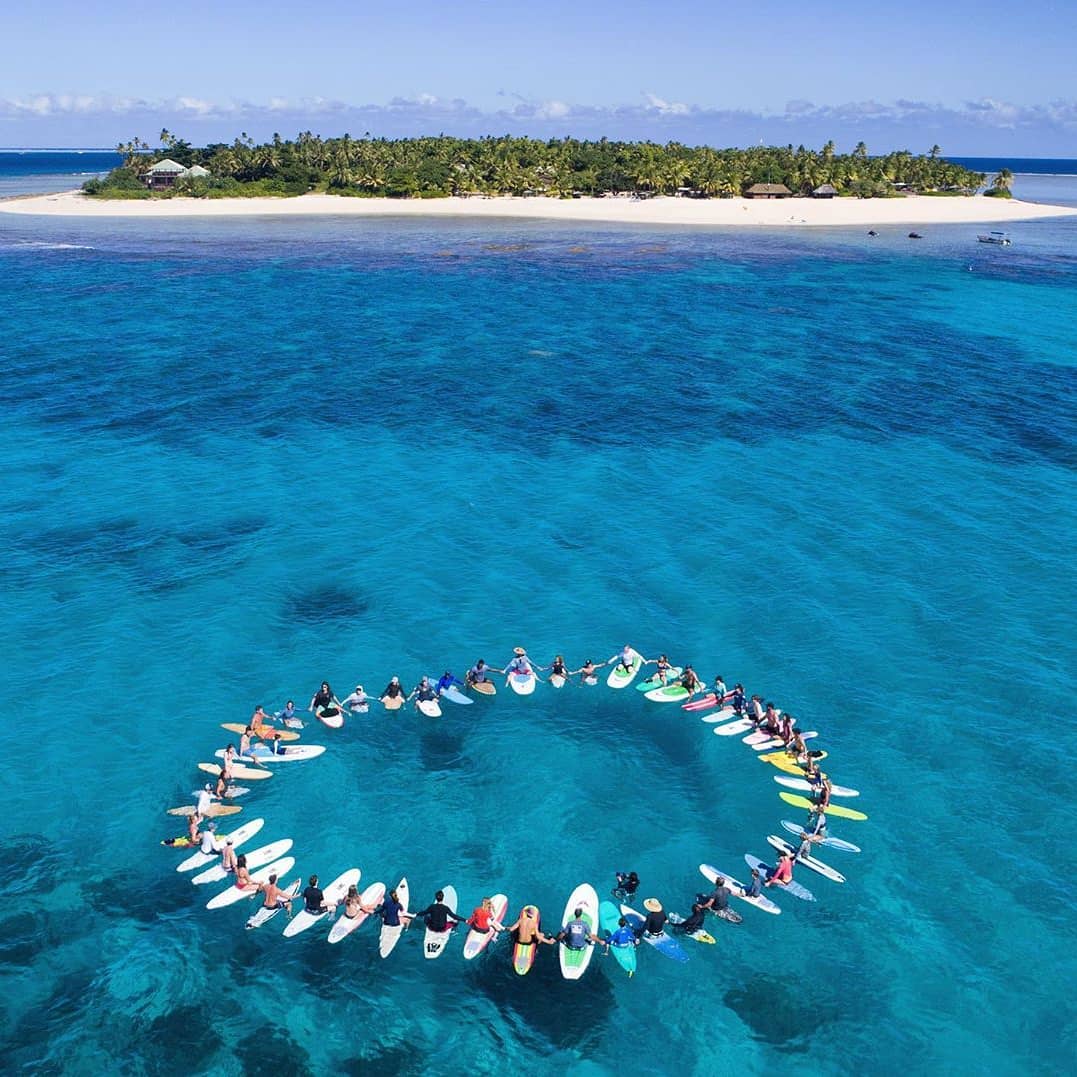It’s a warm Monday morning in the Florida Keys, the sun is just climbing above the horizon, and Ken Nedimyer is headed to the nursery. But it’s not what you think. He’s not dropping off a child or looking to buy a tree or shrub for his garden. In fact, Ken runs this nursery, and two others like it. He isn’t growing plants; he’s growing coral, brood stock that he is using to repopulate the natural reefs that are dying, bleaching, because of warming waters brought about by climate change. He’s on a mission, and he’s worried that he’s running out of time.
I was a professional SCUBA diver for many years, and I’ve spent hundreds of hours of my life gliding over coral reefs, worming my way into deep channels and descending along sheer vertical faces. There is no place on Earth where the profusion of life is as diverse as it is on a reef. The first time I dove on one as a newly minted diver with less-than-perfect buoyancy control skills, I found myself descending too quickly. Frantically, I pumped air into my buoyancy control vest to slow myself down, and as the top of the reef approached, I looked for a landing spot. I wasn’t worried about myself; it was everything else. Every square inch of the reef’s surface was covered with life. Luckily, I stopped my descent in time to avoid the havoc of a slow-motion crash landing, and once I got back in control, I looked around, mesmerized. Nothing had prepared me for what I was suddenly part of.
The colors on a reef are indescribably varied, and the diversity of life is beyond description: anemones, urchins, nudibranchs, tubeworms, moray eels, sponges, tunicates, lobsters, and endless varieties of fish, their movements sparkling the water like a disco ball. And the sounds! Between the snapping shrimp, and the crunching of parrotfish as they nibble on the coral, the “silent world” as Jacques Cousteau called the ocean is anything but silent. Instead, it sounds for all the world like bacon sizzling in a pan.
And of course, there are the corals themselves: staghorn, elkhorn, brain, sea whip, lettuce leaf, carnation, bubble, gorgonian, sun, fox, organ pipe, mushroom, and others too plentiful to name. They include great, boulder-like coral heads, larger than a car, and fantastically branched varieties that spread in all directions like a great pile of antlers. All are stunning, and all are in danger of dying.
The Complex Reef
As he loads gear in the boat that will take him out to the coral nursery, Ken Nedimyer explains the complex world that he is attempting to save. “A reef is a community of corals, interspersed with sponges and soft corals, fish, and lots of invertebrates, every bit as diverse as a tropical rain forest. In fact, the two are similar in some ways. You can’t have a forest without trees, and you can’t have a reef without corals.
“A fire can run through a forest and burn the trees, and for some time, the forest is going to look a lot different. That is analogous to what has happened in much of the Caribbean, where disease and bleaching have run through the coral reef, killing most of the corals. What’s left behind is the structure, but much of it is dead. It’s like the burned trees in the forest. And because of the intricate interdependencies among all the organisms that make up the reef, once they bleach, they don’t attract as many fish, the invertebrates leave, and bad things happen. The whole system is intertwined and interlinked in ways that we’re just now beginning to understand.
“For example, recent research shows that a lot of the planktonic larval fish and invertebrates can hear the sound of the live reef, and they’re drawn to it—the clicking and snapping—but they can also smell it. So, a fish larva can smell live coral, and will change its direction and swim towards that smell, because instinctively, it knows that where there are corals, there is also food and safety. And when it finds it, it’ll settle down and live there. But if it doesn’t detect that smell, and it doesn’t hear that sound, it will drift on by. And the result? A structure that looks like a reef, but there’s nothing there—it’s a ghost town.”
The phenomenon of coral bleaching has been a known problem for some time, but never at the levels that we are currently experiencing. Corals bleach because of a breakdown in their environment, usually the result of climate change. One indicator of climate change, of course, is global warming, and that includes the oceans. A temperature change of as little as two degrees in ocean water can cause corals to become stressed, leading to bleaching, after which they often sicken and eventually die. According to NOAA, the National Ocean and Atmospheric Administration, the ideal temperature range for corals is between 73- and 84-degrees Fahrenheit. This morning, as Ken prepares to leave the dock, the water temperature is just over 89 degrees—well beyond the two-degree fudge factor. That’s more than enough of a temperature differential to create a bleaching event, and the inevitable loss of the vibrant colors that are so much a part of the coral seascape.
Corals are colorful because of the presence in their tissues of microscopic organisms called Zooxanthellae, a family of dinoflagellates that live within the coral in a mutually beneficial symbiotic relationship, each helping the other survive. These tiny dinoflagellates, which are photosynthetic, produce nutrients that feed the tiny animals, the polyps, that create the solid coral that makes up the world’s reefs. The polyps in turn provide the Zooxanthellae with a protected environment and the nutrients they need—carbon dioxide and water—to carry out photosynthesis. But when the environment changes, if it gets too hot, the corals become physiologically stressed, and they expel their photosynthetic partners. As the dinoflagellates leave, the coral fades until it looks like it’s been bleached. If the temperature stays high, the corals won’t allow the dinoflagellates to return, and the corals will die.
Nedimyer elaborates, “When the coral expels the algae from its tissues, the coloring of the coral goes from a brown or a green color to essentially clear. When that happens, what you see is the skeleton of the coral, turned bone white. But at this stage, it’s still alive. It still has a thin layer of tissue growing over the skeleton. But the coral has now lost its main food supply. So, when a bleaching event happens, the clock is ticking. If they don’t recover within a month, then they start to die—they starve to death. And even if they manage to recover, they’re weakened as a result of the bleaching, which makes them more susceptible to disease.”
It’s easy to conclude that the death of a coral reef means nothing more than—well, the death of a coral reef. But it’s a lot more complicated and impactful than that. Reefs serve as powerful barriers against storm surge and hurricanes that would otherwise seriously damage coastlines. Tom Myers, who works with Ken, explains that reefs break up the inbound waves and take much of the energy out of them. “And so all you get,” he explains, “is water rushing through the reef, but not big destructive waves, which is why we can build cities and resort areas along the coast.”
But the reefs are under attack, and if they decline, the result will be economically devastating. According to the report, Climate Change: A Deadly Threat to Coral Reefs, published by the Australian Climate Council, bleaching events are now occurring more frequently across the world’s reefs, and are placing tourism and global economies at risk. How much risk? The report estimates that the predicted loss of corals will cost a staggering $1 trillion. That’s bad, but there’s another factor that isn’t discussed anywhere near often enough.
The world is uniformly incensed over the destruction of the rainforests in places like the Amazon and southeast Asia, and rightly so. But the argument that is most often used as the incentive to stop cutting old growth tropical hardwoods is that the rainforests “are the lungs of the planet.”
It’s true that trees engage in photosynthesis, the magical process by which they combine carbon dioxide, sunlight, and water to create the sugars they need to feed themselves, and, luckily for us and all the other air-breathing organisms on the planet, generate oxygen as a by-product. But rainforests only produce six to nine percent of the world’s oxygen. Meanwhile, as much as half of it is generated by the world’s oceans—specifically, by the photosynthetic microorganisms that float near the surface, close to sunlight, including in and around reef structures.
It is for these reasons that Ken Nedimyer is headed out to visit his nurseries this morning, and why he and his partners formed Reef Renewal USA.
Birth of a Company
“I met Ken in 2007 and was deeply impressed with his commitment to restore the reefs,” says Mike Echevarria, president of the company. He practiced law for 28 years before turning his attention to the ocean. “Ken converted his for-profit business into a not-for-profit company because he believed it was the right thing to do, and he needed some help to make it work. So, I joined him at what at the time was called the Coral Restoration Foundation.
“Reef Renewal got its start in 2017, when four of us who were really involved in the work of restoring our reefs wanted to do more,” says Nedimyer. “I loved watching Jacques Cousteau back in the 60s, and as soon as I could dive—I think I was 14—I got certified and started diving, and started collecting saltwater tropical fish. By the time I was 16, I had a whole bedroom full of aquariums, and since then my interes has never wavered. I went to college at Florida Atlantic University, got a degree in marine biology, and quickly discovered that jobs were pretty scarce. So, I went into commercial lobstering for a while, got into mariculture, and then started my own business, collecting fish and shipping them all over the world for about 30 years.
“During that time, I really got to know the underwater world of the Florida Keys. But I started to get alarmed in the 80s and 90s, because that’s when I started to see coral diseases appearing, and the sea urchins dying off, and the coral starting to bleach. The beauty that I saw when I was diving was starting to disappear. By the end of the 90s, it was really looking bad. I wanted to do something.”
But when Ken looked around, what he saw was a lot of academic activity, but precious little in the way of tangible action. “My bent,” he told me, “is not to study; it’s to do. So, I first started taking steps to restore the long spine sea urchins, which are essential to reef health [they control algae growth and keep the surface of the reef clean so that corals can grow]. And that led me into growing corals and eventually into developing the program that started coral restoration in Florida.”
As is typical of all startups, especially those that fall into the non-traditional ‘let’s make a difference’ world, there was plenty of passion and energy at Reef Renewal USA, even in the beginning. As Mike Echevarria recalls, it came off Ken in waves. “Anybody who got close enough to Ken early on, would quickly find themselves recruited,” he told me. “He would bring friends and neighbors to come out and help. That work has continued, and it’s still largely done by volunteers. That’s important, because I don’t believe there’s enough money to pay for all the restoration that we need. Our goal is to attract communities and let them play a major role in saving the reefs. It’s not hard work, but it’s work, and it has a huge payoff.”
The Work
The nursery that Ken is on his way to visit is one of three that Reef Renewal USA maintains offshore in the Florida Keys where bleaching has become a serious problem. What they have done, in an effort led largely by chief scientist Ken Nedimyer, is identify strains of coral that, for whatever genetic reason, are more resistant to temperature and salinity changes than others and are therefore more resistant to the ravages of climate change.
After identifying these strains, they began to collect them (all with the necessary permits to do so), place them in nurseries, and are now in the process of reestablishing the mature corals on the bleached reefs, where they are thriving, thanks to their natural resistance to the forces that bleached the reef in the first place.
Corals thrive in moving water that carries nutrients, so growing them in the open ocean is the ideal environment for creating brood stock. The Reef Renewal USA team has come up with two different growing structures that support the young corals in the nursery. The first is a piece of polypropylene line that hangs vertically in the water between a float at the top and an anchor at the bottom. The rope is braided, which means that divers can pull open the braid, insert select pieces of branched coral like staghorn and elkhorn, and the poly fibers then hold it in place so they can grow.
The second structure looks like a tree. It's a vertical piece of PVC pipe with horizontal fiberglass cross bars spaced about 18 inches apart. Hanging from the horizontal arms on a fishing line are pieces of the brood stock, live coral, waiting to be mature enough to be transplanted onto the reef. An anchor on the bottom keeps the tree in place. A float at the top keeps it vertical.
“Everybody knows that we regularly get hurricanes and tropical storms here in the Florida Keys,” Ken explains, chuckling and shaking his head as he remembers the early days of the business. “Our first iteration of a coral nursery had concrete blocks on the bottom, and we quickly discovered that hurricanes would just destroy them—pile everything into a big mess and kill everything. That’s how we came up with these tree structures. They sway back and forth in the current, and they do great.”
I asked Ken how the growing and transplantation processes actually work. He told me that it varies depending on the coral species. “Once we identify a climate change-resistant coral head out on the reef, like a brain coral or a star coral [which are large monolithic structures, sometimes as tall as six feet and 900 years old], we’ll take an underwater grinder and cut little pieces off the bottom edge, about the size of a quarter. We then mount them on a blank piece of plastic the size of a credit card, and we write identifying information on the card. We then mount the cards on trays and essentially incubate them in the nurseries. Within a year, those little quarter-size pieces of coral grow and spread and cover the whole card. We then bring the cards back to shore, pop off the coral, cut each piece into a bunch of smaller pieces, and put quarter-sized pieces back on the same cards, ready to be taken back out to the nursery for a year of growth. Meanwhile, some of the pieces get mounted on little ceramic disks that are then glued to the bleached coral heads on the reef. That’s how we’re growing the brain corals and the star corals and the corals that form great big coral heads.”
I asked him about the other corals, the beautiful and intricate branched varieties, and whether they are grown in the same way.
“It’s a similar process,” he explained. “We take a long branch of those corals, like the elkhorn and staghorn varieties, cut it into a bunch of pieces, hang each piece by a piece of monofilament on one of the trees, and it grows like crazy.”
Outreach
An organization like Reef Renewal USA depends on volunteers, which means that it also depends on word-of-mouth to spread the message of reef recovery that they are working so hard to achieve—and their constant need for volunteers. I asked Tom Myers about the organization’s outreach efforts.
“One of the things that’s really important for us is to educate the public about the long-term importance of what we’re doing, starting as young as kids in kindergarten. Our goal is to educate young folks about the importance of our natural reefs, and about protecting and maintaining and growing them. So, we have mobile units that travel to different schools with brood coral in tanks, and once there, our team shows students how to cut the coral and then glue the pieces on the plugs that we use, so that they can then be planted out on the reef.
“We’re very dependent on volunteers, as I said earlier, but our need isn’t restricted to certified SCUBA divers. The beauty of our model is that anyone, diver or not, can help us restore the reefs. We have a series of online training videos that volunteers complete to prepare for the process of cleaning the coral, cleaning the trees in the nursery, planting corals, ensuring diver safety, being aware of the protocols of working in a coral nursery, and so on. So, if you’re a volunteer and you’ve come down to help, by the time you get to the site, you already have a pretty good idea of what you’re going to be doing.”
And while Reef Renewal USA is North America-centric, they are part of a global network of organizations working in concert to protect and preserve the world’s coral reefs. As a result, the training they offer online can be used all over the world because of the way the organization has partnered with other groups. “If you take our online training,” says Myers, “then you can work with our partners in Australia on the Great Barrier Reef, or you can go to Bonaire, or Curacao, or Mustique, or any other islands in the Caribbean where reef restoral projects are underway. There are never enough people to support and do all this work, so volunteers are welcome all over the world.”
A Typical Day
I asked Tom what a typical day is like for the volunteers who take the training and then come down to help.
“Like I said, there’s always work that needs to be done,” he began. “I’ll start with the activities that divers do. We meet at the docks and get on the boat with a divemaster or nursery manager, who explains what they’re going to be doing that day. It could be anything from going down to clean the trees with brushes or cleaning the coral itself; it could be going down to plant some of the coral pieces on a bleached reef. For non-divers, it could be mixing the cement on the boat, cutting coral with a tile saw, arranging the cut coral pieces in different tanks, or building trees for the nurseries. It could be attaching coral pieces to ceramic or cement plugs and then putting them into a tray of plastic mesh, ready for the divers to take them below to be placed in the nursery. There are many, many, things that could happen in a given day.”
The overall goal of Reef Renewal USA is to grow climate change-resistant corals, and then replant them on the reef. And while Ken and his colleagues have chosen to grow corals in offshore nurseries, other organizations use large land-based “incubator”systems. Reef Renewal decided to build offshore facilities for two reasons: cost and ecology. The Florida Keys are famous for breathtakingly expensive real estate, and Ken, Tom and Mike wanted to spend their funds on coral restoration, not on buildings. And second, the habitat in which corals naturally grow is a better environment for them overall. Permits for ocean-based facilities are readily available from state and federal agencies, and the cost to acquire them is reasonable. And because the coral brood stock is suspended in the water column, the polyps have ready, natural access to clean oxygenated water and the nutrients they require that move around in the currents. When the corals are ready to be harvested for planting on the reef, divers carefully remove the pieces from the trees or from cards in the nurseries, and take them out to the reef in a tank on one of Reef Renewal’s boats.
I asked Ken how they’re actually attaching the live coral to the bleached reef. “We’re using cement now,” he told me. “We use basic Portland cement, which we mix on the boat and then pour into a deli cup like you’d get soup in from a Chinese restaurant. We take those cups full of cement down to the reef, tip it upside down, pull the cup off, and then plant the corals in that wet cement. Within an hour or two, the cement starts to harden, and overnight, it’s rock hard. The corals grow over the dome of cement, and soon cover it completely.”
One of the things I was curious about was the degree of genetic diversity that they have been able to develop. Hybrid vigor, the biological mandate that limits inbreeding in species, is critical, especially in scenarios where organisms are endangered or on the brink of extinction. When biodiversity becomes limited in an ecosystem, monocultures result. It’s the same problem that the forestry industry worries about when they replant forests with a single species of harvestable tree, or when people looking to restore a prairie grassland strive to put it back in its original, pre-agriculture condition. If a single species is planted, and that single species tends to attract smaller numbers of ecosystem partners, the ecosystem is more susceptible to disease and overall is less hardy, especially today, as climate change affects everybody and everything. Monocultures don’t do the environment any favors, so I was pleasantly surprised by Ken’s response.
“In our nursery, we have 22 species, and 750 different genetic strains of coral. So, we have to keep track of every one of those genotypes, because they’re all unique and they’re all special. And we’ve gone out of our way to find and collect corals from heat stressed areas that for whatever reason have survived. We didn’t just go out onto the reefs and collect random corals; we were very, very selective about the ones we collected and began to breed.”
The Business
As the president of Reef Renewal USA, Mike Echevarria manages the business side of the company—in essence, taking care of the things that ensure that the organization will still be not only operating but flourishing well into the future. He’s a diver, yes, but his focus is on financials and marketing and strategy, largely leaving the science to Ken and the education and outreach to Tom, along with the work done by the volunteers that help them do what they do.
“We needed a vehicle to take the innovation and optimism for restoring coral reefs that Ken has and build an organization around those qualities that would carry it on into the future. My job is to help the organization build something that’s sustainable, all on a foundation of the values that Ken brings to the table—being innovative and passionate about creating hope and a legacy for the future. That means creating an organization that will also attract the next generation to continue the work.
“Once you get out to the nurseries, and you see what we’re doing, all of a sudden, there’s a revelation, a moment of empowerment when people realize that something very important is going on here and they’re about to be part of it.
“But it isn’t just about inspiring individuals. In order to have a coral nursery, you have to comply with very stringent permitting through Florida Fish and Wildlife. We work with several universities and marine science laboratories, and through those relationships we now have labs that are open for academia to do research. We’re also working with a couple of large aquariums, and now they’re helping to foster growth on the reefs with their own projects. Many of them have corals in their tanks that were rescued from impoverished habitats, and they don’t want to keep that coral in their tanks in perpetuity—they’d rather get it back to where it came from. We help them do that.”
So, what’s the end game? As I was researching this story, I found myself drawn back to The Undersea World of Jacques Cousteau, the television program that helped set me on my own path many decades ago. As it happens, the entire series is available on YouTube, so for several pleasant, poignant hours, I went down a rabbit hole. Memories came flooding back as I watched Cousteau and his team do their thing aboard the Calypso. There they were, lined up on the rail in their signature red Speedos and wool diving hats, and at that moment, there was nothing I wanted more viscerally than to be standing there with them.
But then, in one of the episodes, Cousteau said something in his universally recognizable voice that stopped me in my tracks. The episode I was watching was released in April of 1976, and toward the end, he said these prophetic words:
Coral is as important as the Amazonian rainforest in carrying out the carbon fixing that can counteract the greenhouse effect that causes global warming.
He said that 47 years ago. We didn’t listen then; perhaps we’ll listen now.
Ken’s boat is approaching the buoy field that marks one of the underwater nurseries. He ties up to one of them—no dropped anchors, please, babies sleeping below—and gazes across the gentle swells.
“I’m selling hope and buying time,” he says. “If I can get people to hope and invest their time and energy and funds to help us do this good work, then we can buy time. But you know, there’s a limit to what a small number of dedicated people can do. So, if we can get other people to believe in what we’re doing, then I think we can buy some time and make a difference for the corals. If we can buy enough time, we just might save some of these species and some of this beauty that I’ve grown up seeing.” His face takes on a gentle intensity. “I’d love to have my grandkids be able to see even a glimpse of what I’ve seen, but if we quit, there’s no hope of that ever happening. If we keep persevering, I know in my heart that they’ll be able to see corals that have survived and thrived in conditions that they shouldn’t be able to live in. To do nothing is to condemn them to extinction; why would we do that when we have the ability to avoid such a tragedy?”
To learn more about Reef Renewal and how to become a volunteer, please visit www.ReefRenewalUSA.org.

